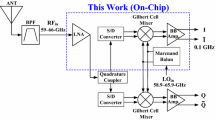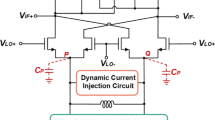Abstract
In the past few years, the mm-wave silicon, especially 60 GHz CMOS design has experienced a transition from an obscure topic to a research hot spot. This paper presents the design of a 60 GHz receiver front-end using 65 nm CMOS technology. Initially, a heterodyne receiver front-end architecture is presented to exploit its possible compatibility with legacy systems. In order to implement the front-end, an EM simulation based methodology and the corresponding design flow are proposed. A transistor EM model, using existing compact models as core, is developed to account for the parasitic elements due to wiring stacks. A spiral inductor lumped model, based on S-parameter data from EM simulation is also derived. After the device modeling efforts, a single-stage LNA and a single-gate mixer are designed using 65 nm CMOS technology. They are characterized by EM co-simulation, and compared with the state-of-the-art. After integration, the simulated front-end achieves a conversion gain of 11.9 dB and an overall SSB noise figure of 8.2 dB, with an input return loss of −13.7 dB. It consumes 6.1 mW DC power, and its layout occupies a die area of 0.33 mm × 0.44 mm.














Similar content being viewed by others
References
Smulders, P. (2003). 60 GHz radio: prospects and future directions. In Proceedings symposium on communications and vehicular technology, pp. 1–8.
Ta, C., Wicks, B., Zhang, F., Yang, B., Mo, Y., Wang, K., et al. (2007). Issues in the Implementation of a 60 GHz transceiver on CMOS. In 2007 IEEE international workshop on radio-frequency integration technology, pp. 135–140.
Smulders, P. (2002). Exploiting the 60 GHz band for local wireless multimedia access: Prospects and future directions. IEEE Communications Magazine, 2(1), 140–147.
Niknejad, A., & Hashemi, H. (2008). mm-Wave silicon technology: 60 GHz and beyond. New York: Springer.
Hese, J. V., Sercu, J., Pissoort, D., & Lee, H. (2008). State of the art in EM software for microwave engineers [white paper]. Retrieved from http://cp.literature.agilent.com/litweb/pdf/5990-3225EN.pdf.
Cohen, E., Ravid, S., & Ritter, D. (2008). An ultra low power LNA with 15 dB gain and 4.4db NF in 90 nm CMOS process for 60 GHz phase array radio. In Proceedings of the 2008 IEEE radio frequency integrated circuits symposium, pp. 61–64.
Emami, S., Doan, C., Niknejad, A., & Brodersen, R. (n.d.). Large-signal millimeter-wave CMOS modeling with BSIM3. In Proceedings of the 2004 IEEE radio frequency integrated circuits symposium, pp. 163–166.
Liang, C., & Razavi, B. (2009). Systematic transistor and inductor modeling for millimeter-wave design. IEEE Journal of Solid-State Circuits, 44(2), 450–457.
IBM Microelectronics (2008). On-chip inductors and their figures of merit [white paper].
Sia, C., Yeo, K. S., Do, M. A., & Ma, J. (2003). Metallization proximity studies for copper spiral inductors on silicon. IEEE Transactions on Semiconductor Manufacturing, 16(2), 220–227.
Ellinger, F. (2008). Radio frequency integrated circuits and technologies (2nd ed.). New York: Springer.
Doan, C., Emami, S., Niknejad, A., & Brodersen, R. (2005). Millimeter-wave CMOS design. IEEE Journal of solid-state circuits, 40(1), 144–155.
Heydari, B., Bohsali, M., Adabi, E., & Niknejad, A. (2007). Low-Power mm-Wave Components up to 104 GHz in 90 nm CMOS. In IEEE international solid-state circuits conference, 2007. ISSCC 2007. Digest of technical papers, pp. 200–597.
Varonen, M., Karkkainen, M., Kantanen, M., & Halonen, K. A. (2008). Millimeter-wave integrated circuits in 65-nm CMOS. IEEE Journal of Solid-State Circuits, 43(9), 1991–2002.
Emami, S., Doan, C., Niknejad, A., & Brodersen, R. (2005). A 60-GHz down-converting CMOS single-gate mixer. In IEEE radio frequency integrated circuits symposium, pp. 163–166.
Motlagh, B., Gunnarsson, S., Ferndahl, M., & Zirath, H. (2006). Fully integrated 60-GHz single-ended resistive mixer in 90-nm CMOS technology. IEEE Microwave and Wireless Components Letters, 16(1), 25–27.
Acknowledgment
The authors would like to thank the Swedish Research Council (VR) for funding this work. They would also like to thank Dr. Andrzej Ciminski, Ronny Peschel and Dr. Juergen Hartung from Agilent Technologies for their kind advices and technical supports.
Author information
Authors and Affiliations
Corresponding author
Rights and permissions
About this article
Cite this article
Tao, S., Rodriguez, S., Rusu, A. et al. A 60 GHz receiver front-end in 65 nm CMOS. Analog Integr Circ Sig Process 67, 61–71 (2011). https://doi.org/10.1007/s10470-010-9510-8
Received:
Revised:
Accepted:
Published:
Issue Date:
DOI: https://doi.org/10.1007/s10470-010-9510-8




